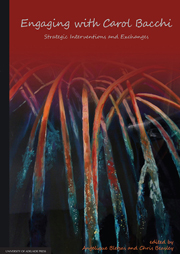Book contents
- Frontmatter
- Contents
- Acknowledgements
- List of Contributors
- Introduction
- Part I Looking back: On beginning
- Part II Strategic interventions and exchanges: Reflections and applications of the ‘What's the Problem Represented to be?’ approach
- 2 Introducing the ‘What's the Problem Represented to be?’ approach
- 3 Women, Policy and Politics: Recasting policy studies
- 4 Spaces between: Elaborating the theoretical underpinnings of the ‘WPR’ approach and its significance for contemporary scholarship
- 5 Digging deeper: The challenge of problematising ‘inclusive development’ and ‘disability mainstreaming’
- 6 Answering Bacchi: A conversation about the work and impact of Carol Bacchi in teaching, research and practice in public health
- 7 Located subjects: The daily lives of policy workers
- Additional interventions: Select reading list
- Part III Strategic exchanges: The wider context
- Part IV Looking forward: Still engaged
5 - Digging deeper: The challenge of problematising ‘inclusive development’ and ‘disability mainstreaming’
from Part II - Strategic interventions and exchanges: Reflections and applications of the ‘What's the Problem Represented to be?’ approach
Published online by Cambridge University Press: 05 June 2013
- Frontmatter
- Contents
- Acknowledgements
- List of Contributors
- Introduction
- Part I Looking back: On beginning
- Part II Strategic interventions and exchanges: Reflections and applications of the ‘What's the Problem Represented to be?’ approach
- 2 Introducing the ‘What's the Problem Represented to be?’ approach
- 3 Women, Policy and Politics: Recasting policy studies
- 4 Spaces between: Elaborating the theoretical underpinnings of the ‘WPR’ approach and its significance for contemporary scholarship
- 5 Digging deeper: The challenge of problematising ‘inclusive development’ and ‘disability mainstreaming’
- 6 Answering Bacchi: A conversation about the work and impact of Carol Bacchi in teaching, research and practice in public health
- 7 Located subjects: The daily lives of policy workers
- Additional interventions: Select reading list
- Part III Strategic exchanges: The wider context
- Part IV Looking forward: Still engaged
Summary
…the intent is to dig deeper than usual into the meaning of policies and into the meaning-making that is part of policy formulation…the focus on methodology and application means that the [‘WPR’] approach is easily adaptable to other settings. (Bacchi 2009: vi)
As Carol Bacchi makes clear, the ‘What's the Problem Represented to be?’ (‘WPR’) approach offers ‘both a novel way of thinking and a new way of analysing policy’ (Bacchi 2009: xvi). The ‘WPR’ approach aims to serve two purposes. Firstly, as a mode of thinking, the approach shifts the focus of analysis from policy as a ‘problem solving’ exercise, a technical, neutral and responsive process, to a mode of thinking that sees policy as an act which is constructive of ‘problems’, political and contingent. This enables us to call into question the ‘problems’ inherent in specific policy proposals and dig deeply into the meaning-making that they are both reflective and constitutive of. Secondly, as a form of analysis, the ‘WPR’ approach provides a clear methodology, based around a set of six guiding questions, to enable application of its way of thinking across boundaries of policy context and content.
Much of the development and application of the ‘WPR’ approach to date has been in relation to domestic public policy, often, though by no means exclusively, Australian. This chapter explores what it can mean to embrace the approach's mode of thinking and apply its form of analysis to new contexts and forms of policy by reflecting on its application within my ongoing PhD research.
Information
- Type
- Chapter
- Information
- Engaging with Carol BacchiStrategic Interventions and Exchanges, pp. 53 - 70Publisher: The University of Adelaide PressPrint publication year: 2012
Accessibility standard: Unknown
- 11
- Cited by
